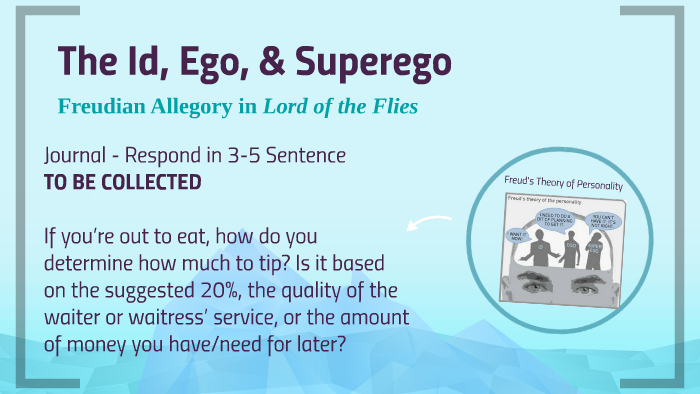

Our drives (Freud had very theoretically specific "-drives" such as the death-drive, but drives can often be equated to 'instincts') surge forth from the id and apply libidinal energy to objects, which may result in aggressive or erotic attachments/actions upon chosen objects. 'The libido' or simply 'libido', is the form of energy cathected upon objects or an affect received from objects, predominantly sexual, which underlies all mental processes. The id, as previously stated, is the source of our drives and Freud considered it to be the reservoir of libido. "Tip of the Iceberg" - Structural and Topographical Models of Mind The 'ego', the 'id', and the 'ideal of the ego' were previously used in Group Psychology and Ego Analysis (1922) Freud would later replace the "Ideal of the Ego" with the Super-Ego.

the conscious, preconscious and unconscious). However, the first traces of the theory appear in his essay Beyond the Pleasure Principle (1920), in which it was introduced due to his dissatisfaction with his topographic scheme (i.e. Most place the theory's beginnings with Freud's 1923 writing The Ego and the Id, in which he firmly established his structural theory.

The repressed is only cut off sharply from the ego by the resistances of repression it can communicate with the ego through the id." (Model of the mind which appears in Freud's 1923 paper "The Ego and the Id") But the repressed merges into the id as well, and is merely a part of it. "The ego is not sharply separated from the id its lower portion merges into it. The “id” (fully unconscious) contains the drives and those things repressed by consciousness the “ego” (mostly conscious) deals with external reality and the “super ego” (partly conscious) is the conscience or the internal moral judge ( The Freud Exhibit: L.O.C.). In 1923, Freud introduced new terms to describe the division between the conscious and unconscious: 'id,' 'ego,' and 'super-ego.' He thought these terms offered a more compelling description of the dynamic relations between the conscious and the unconscious. The Id, Ego, and Super-Ego are the divisions of the psyche according to psychoanalyst Sigmund Freud's "structural theory".


 0 kommentar(er)
0 kommentar(er)
